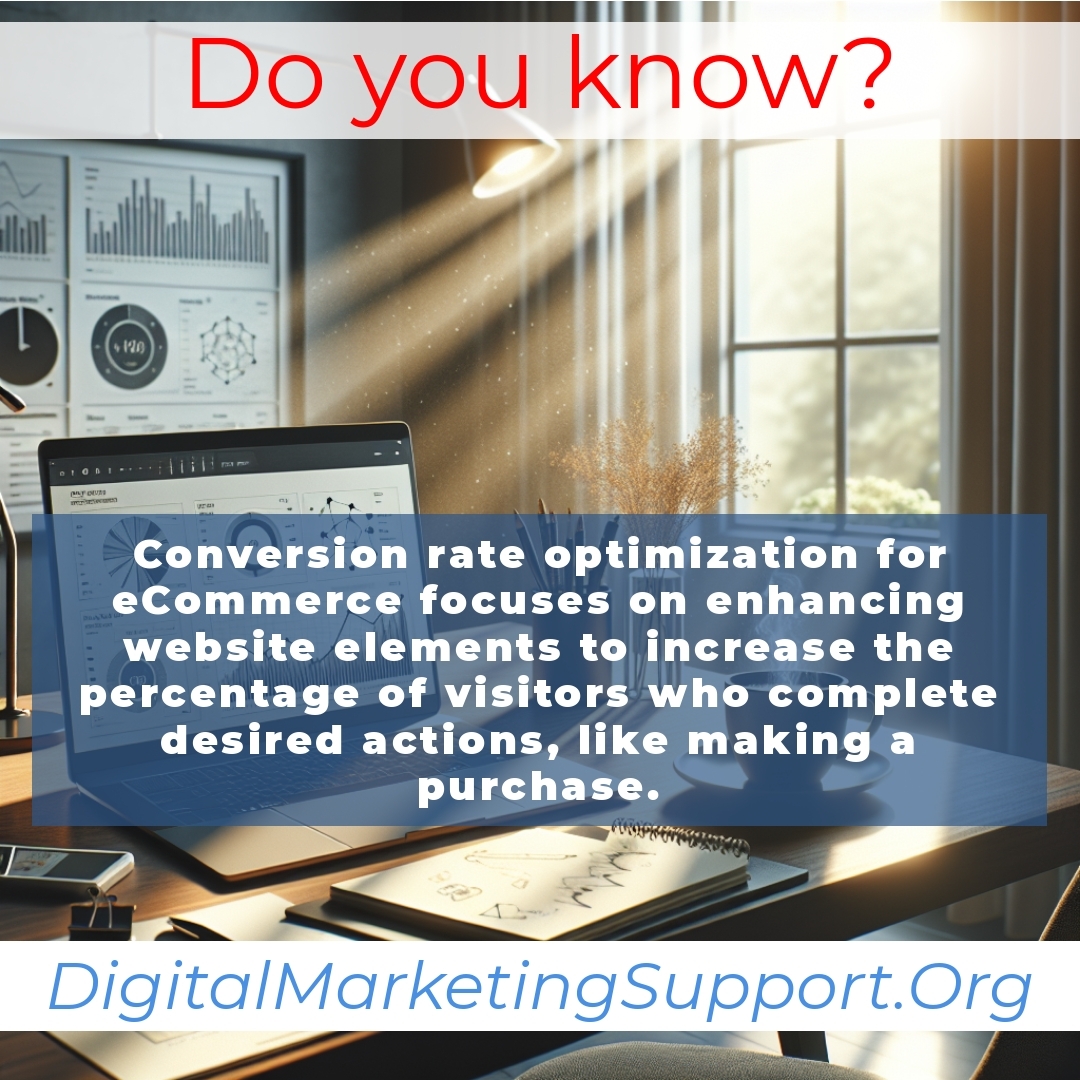In the competitive world of eCommerce, Conversion Rate Optimization (CRO) plays a crucial role in driving sales and enhancing customer loyalty. By optimizing the eCommerce Conversion Rate, businesses can significantly boost revenue while creating a more satisfying shopping experience. Focusing on user experience and rigorous testing is essential for achieving better conversion outcomes.
“Small changes can lead to big sales; optimize every step.”

Understanding Conversion Rate Optimization
Definition of Conversion Rate Optimization
Conversion Rate Optimization, or CRO, is all about enhancing your website to encourage more visitors to take desired actions, whether that’s making a purchase, signing up for a newsletter, or any other goal you set. It involves analyzing user behavior, making data-driven changes, and continually testing to find what works best.
Importance of High eCommerce Conversion Rates
A high eCommerce Conversion Rate can make a significant difference in your store’s success. It means more sales without necessarily increasing traffic, leading to better revenue and efficiency. Focusing on improving the user experience is key to achieving higher conversion rates, as happy customers are more likely to complete their purchases and return in the future.
Key Strategies for Improving eCommerce Conversion Rates
User Experience Optimization
User Experience Optimization in eCommerce is about designing your website in a way that makes it easy and enjoyable for customers to navigate and complete their purchases. This includes intuitive navigation, fast loading times, and a mobile-friendly design.
Elements like clear product images, straightforward menus, and a seamless checkout process can greatly impact your eCommerce Conversion Rate. By focusing on Ecommerce UX Design, you ensure that visitors have a positive interaction with your site, making them more likely to convert.
A/B Testing
A/B Testing is a powerful tool in CRO that helps you determine which changes to your website lead to better performance. By comparing two versions of a webpage, you can see which one resonates more with your audience.
Common elements to test include headlines, images, and layouts. For example, you might test two different call-to-action buttons to see which one gets more clicks, helping you make informed decisions that boost your eCommerce Conversion Rate.
Landing Page Optimization
Your landing pages are often the first impression potential customers have of your brand. Optimizing these pages is crucial for driving conversions. This involves creating clear, compelling content and ensuring that the design supports your conversion goals.
Tips for effective landing page design include using strong headlines, high-quality images, and clear calls to action. A well-optimized landing page can significantly increase your chances of turning visitors into customers.
Funnel Optimization
Funnel Optimization focuses on smoothing the path that users take from their first visit to completing a purchase. This means reducing any friction points that might cause them to abandon their cart.
Best practices include simplifying the checkout process, offering multiple payment options, and providing clear progress indicators. Ensuring a seamless transition through each stage of the funnel can greatly enhance your eCommerce Conversion Rate.
Call to Action (CTA) Effectiveness
Effective CTAs are essential for guiding users toward taking the desired action on your site. They should be clear, compelling, and strategically placed to capture attention.
Tips for crafting compelling CTAs include using action-oriented language, making them stand out with contrasting colors, and ensuring they are relevant to the content surrounding them. A strong CTA can significantly boost your conversion rates.
Bounce Rate Reduction
Reducing your site’s bounce rate can lead to a higher eCommerce Conversion Rate. Bounce rate refers to the percentage of visitors who leave your site after viewing only one page.
Strategies to keep users engaged include improving page load times, offering valuable content, and ensuring your website is easy to navigate. By making a great first impression, you can encourage visitors to explore more of your site and ultimately convert.
Best Practices for eCommerce Conversion Rate Optimization
Implementing best practices in CRO ensures that your optimization efforts are effective and sustainable. Key practices include:
- Conducting regular A/B testing to identify what works best.
- Focusing on mobile optimization, as more users shop on their phones.
- Using high-quality images and detailed product descriptions.
- Streamlining the checkout process to reduce cart abandonment.
- Leveraging social proof, such as reviews and testimonials, to build trust.
Insights from industry leaders highlight the importance of continuous testing and adapting to user feedback. Studies show that businesses that prioritize CRO see significant improvements in their eCommerce Conversion Rates and overall profitability.
Long Tail Keywords: Actionable Tips and Strategies
How to Improve Conversion Rate for eCommerce Stores
Improving the conversion rate for eCommerce stores involves a mix of strategies tailored to your specific audience. Start by analyzing your current performance metrics to identify areas for improvement. Implement user experience optimization, conduct A/B testing, and refine your landing pages based on data-driven insights.
Additionally, ensure your site is mobile-friendly, as a large portion of traffic comes from mobile devices. Personalizing the shopping experience and offering incentives like discounts or free shipping can also help increase your conversion rates.
Tips for Increasing Online Sales Through Conversion Optimization
To boost online sales, focus on creating a seamless and enjoyable shopping experience. Ensure that your website loads quickly, is easy to navigate, and that product information is clear and detailed. High-quality images and videos can help customers better understand what they’re purchasing.
Implementing effective CTAs and simplifying the checkout process are also crucial. Providing multiple payment options and offering guest checkout can reduce barriers to purchase, leading to more completed sales.
Importance of A/B Testing in eCommerce Conversion Rates
A/B Testing plays a pivotal role in improving eCommerce conversion rates by allowing you to test different elements of your website and see what resonates best with your audience. For example, you can test different headlines, images, or button colors to determine which version performs better.
Case studies have shown that even minor changes through A/B Testing can lead to significant increases in conversion rates. By continually testing and optimizing, you can ensure that your website evolves to meet the needs and preferences of your customers.
Strategies to Enhance User Experience on eCommerce Websites
Enhancing user experience on your eCommerce website involves making it easy for visitors to find what they’re looking for and complete their purchases without frustration. Start by ensuring your site is intuitive and navigable, with clear categories and search functionality.
Improve site speed, use responsive design for mobile users, and provide detailed product information. Additionally, offering excellent customer support and easy return policies can enhance the overall user experience, encouraging customers to return and recommend your store to others.
Conclusion
Conversion Rate Optimization is a critical element in the success of eCommerce businesses. By focusing on strategies that enhance the eCommerce Conversion Rate, such as user experience optimization, A/B testing, and effective funnel management, businesses can achieve higher revenues and foster stronger customer loyalty.
Implementing user-focused strategies and continuously testing and refining your approach ensures that your eCommerce site remains competitive and meets the evolving needs of your customers. Embrace CRO as an ongoing process to drive sustained growth and success in the eCommerce landscape.
What is Conversion Rate Optimization (CRO)?
Conversion Rate Optimization, or CRO, is the process of improving your website to encourage visitors to take specific actions, like making a purchase or signing up for a newsletter. It involves analyzing user behavior, making data-driven adjustments, and testing different strategies to see what works best.
Why is a high eCommerce conversion rate important?
A high eCommerce conversion rate can significantly boost your store’s revenue without needing to increase traffic. It reflects that more visitors are completing their purchases, which often results from a better user experience. Happy customers are more likely to return and purchase again.
How can I optimize user experience for better conversion rates?
- Design intuitive navigation for easy browsing.
- Ensure fast loading times to keep visitors engaged.
- Make your website mobile-friendly to cater to smartphone users.
- Use clear product images and straightforward menus.
- Streamline the checkout process to enhance user satisfaction.
What is A/B testing and how does it help?
A/B testing involves comparing two versions of a webpage to see which one performs better. By testing different elements like headlines, images, and button styles, you can determine what resonates more with your audience, allowing for informed decisions that can increase conversions.
How important is landing page optimization?
Landing page optimization is critical because these pages often form the first impression potential customers have of your brand. Effective landing pages should include:
- Strong, clear headlines.
- High-quality images.
- Clear calls to action that guide users.
Optimizing these elements can significantly enhance your conversion chances.
What strategies can reduce bounce rate?
- Improve page load times to keep users engaged.
- Provide valuable content that invites exploration.
- Ensure easy navigation to encourage users to browse further.
Creating a great first impression helps in lowering bounce rates and can lead to higher conversions.
What best practices should I follow for CRO?
- Conduct regular A/B testing to find out what works best.
- Focus on mobile optimization to accommodate the growing number of mobile shoppers.
- Utilize high-quality images and detailed product descriptions.
- Simplify the checkout process to reduce abandoned carts.
- Leverage social proof, like reviews and testimonials, to build trust.
What are the benefits of personalizing the shopping experience?
Personalizing the shopping experience can make customers feel valued, leading to higher engagement and conversion rates. Simple personalization tactics include:
- Recommending products based on past purchases.
- Sending targeted emails with offers that match user interests.
- Creating unique landing pages for different customer segments.
How can I enhance user experience on my eCommerce website?
To improve user experience, focus on:
- Making the site intuitive and easy to navigate.
- Improving site speed for a seamless browsing experience.
- Providing detailed product information and support.
- Offering clear return policies and customer support options.








